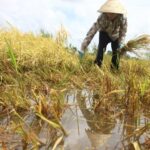
Cosmos caudatus, commonly known as Cosmos or Mexican Aster, is an annual herb native to the tropical regions of South America. It is a member of the Asteraceae family and is closely related to the well-known Cosmos bipinnatus and Cosmos sulphureus.
The flowers of Cosmos caudatus are typically solitary or arranged in loose clusters at the top of the plant. Each flower consists of eight delicate petals surrounding a central yellow disc. Of the three Cosmos species, Cosmos caudatus is particularly prized for its superior nutritional content.

Cosmos caudatus can grow up to 2 meters in height, with some specimens reaching up to 3 meters. Its stems are erect and branched, forming dense bushes. The leaves are light green with a purplish tinge and are deeply lobed, resembling tiny spears. The leaf stalks develop into sheaths that enclose the stem and can grow up to 20 cm in length.
The leaves of Cosmos caudatus have a mild aroma and a soft texture, making them ideal for culinary use. They can be consumed raw in salads or alongside other herbs, wrapped in rice paper with pork, or served with various types of fermented dishes such as fish, shrimp, or meat stews.

In addition to their culinary uses, the leaves of Cosmos caudatus can be incorporated into dishes like Vietnamese savory pancakes, herbal salads, or stir-fried with garlic. When consumed raw, the leaves offer a unique blend of sweet, sour, and slightly bitter flavors. However, when boiled or stir-fried, they exude a rich, earthy taste characteristic of green vegetables.
Aside from its culinary appeal, Cosmos caudatus is also valued for its nutritional benefits. It is an excellent source of vitamins A and C, polyphenols, and antioxidants. Regular consumption of this herb is believed to promote blood purification and enhancement, combat aging, and prevent osteoporosis.

It is important to distinguish Cosmos caudatus from its close relative, the Cosmos sulphureus, commonly known as the Butterfly Flower. While both plants belong to the same genus, they differ in several aspects. The Butterfly Flower produces larger blooms and lacks the fragrant leaves of Cosmos caudatus. Additionally, the leaves of the Butterfly Flower are not edible, and this plant is primarily cultivated for its ornamental value.
Therefore, when foraging for Cosmos caudatus or purchasing it from local markets, it is crucial to accurately identify the species to ensure safe consumption.

The Butterfly Flower, with its larger blooms, is often favored for its ornamental qualities.

The edible Cosmos caudatus has smaller flowers compared to the Butterfly Flower.
Growing Cosmos caudatus at Home
To cultivate Cosmos caudatus, you can either purchase seeds or young plants from nurseries or propagate them yourself. For seed germination, simply sow the seeds directly into moist soil, cover them with a thin layer of soil, and maintain adequate moisture.
Alternatively, if you have access to mature plants, you can propagate Cosmos caudatus through stem cuttings, similar to other herbs. Cut 15-20 cm long stem segments from a healthy, mature plant, ensuring that each cutting has at least one or two nodes (the points where leaves emerge) in contact with the soil.
Within one to two weeks, the seeds or cuttings will sprout and develop roots.

Here are some essential care tips for your Cosmos caudatus:
– Soil: Cosmos caudatus thrives in well-drained, nutrient-rich, loamy soil. Mix organic matter or well-rotted manure into the soil to provide a continuous supply of nutrients. If you don’t have a garden, you can grow Cosmos caudatus in pots or containers.
– Light: Cosmos caudatus prefers full sun exposure. However, if grown in containers, provide some shade during the hottest part of the day to prevent scorching.
– Watering: Cosmos caudatus requires moist soil but be careful not to overwater. Regular watering is essential, especially during hot and dry periods.
– Fertilizer: Once the plant starts producing young leaves, you can apply organic fertilizer or NPK fertilizer to promote growth. Fertilize periodically, about once a month.
With proper care, your Cosmos caudatus will thrive and produce an abundance of tender young leaves. You can start harvesting after about one to two months when the plant reaches a height of around 30-40 cm. Simply cut the leaves as needed and enjoy their unique flavor and nutritional benefits.




































